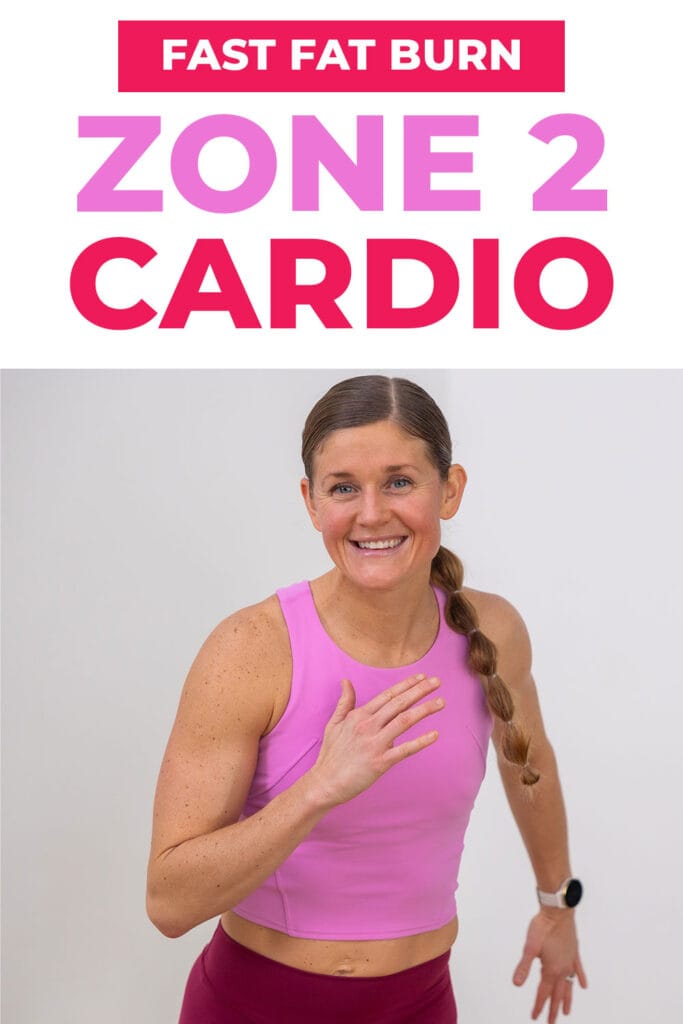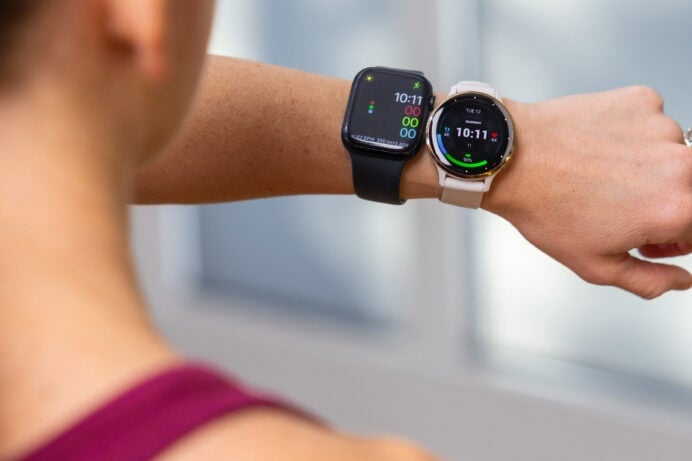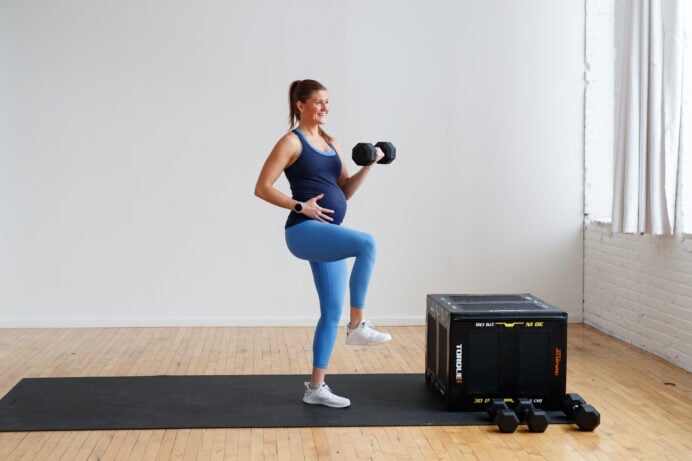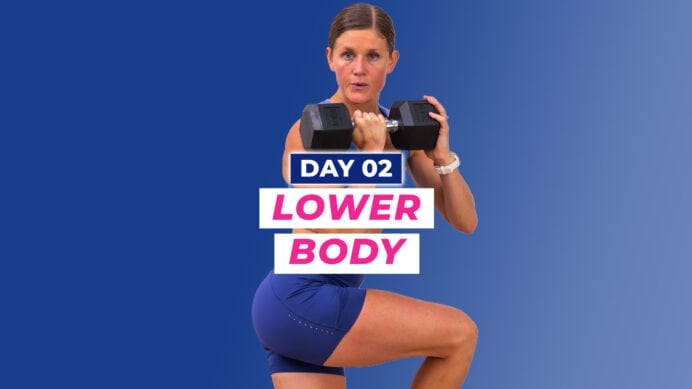
What Is Zone 2 Cardio?
Zone 2 cardio is a type of aerobic exercise that involves working at a moderate intensity (typically 60-70% of your maximum heart rate) for an extended period of time. It’s one of the fastest-growing workout trends due to both its accessibility and health benefits. This approachable form of cardio is effective for everyone from beginners to advanced fitness enthusiasts.
Quick Links:
Zone 2 cardio is so popular, it has about a dozen different names depending on who you’re talking to.
Whether you call it zone 2 training, base training, low-intensity steady-state (LISS) cardio, Maffetone Training, endurance training or longevity cardio, as a certified personal trainer, I believe that this style of aerobic training should be a staple in your weekly fitness routine.
The 5 Zones
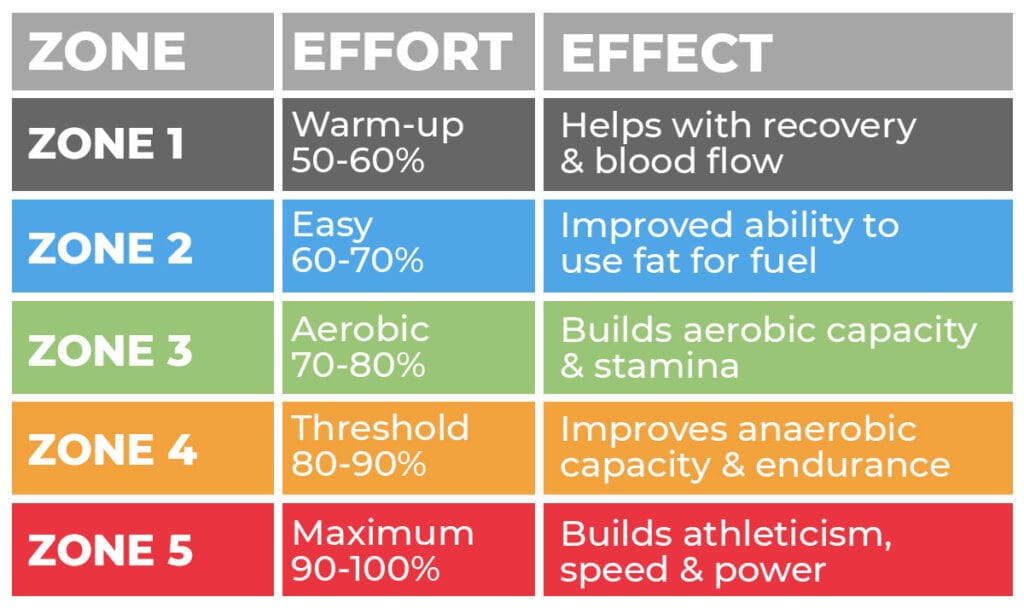
Heart rate training is a method of exercise where you use your heart rate (how fast your heart is beating) to guide the intensity of your workouts. I like this style of training because it allows you to train smarter, not harder.
There are five heart rate “zones” which are based on a percentage of your maximum heart rate (MHR). To estimate your max heart rate, subtract your age from 220.
- Zone 1: warm-up/low effort, such as an easy walk or gentle stretching. In this zone, your heart rate should be between 50-60% of MHR, and you should be able to easily maintain this intensity for an extended period.
- Zone 2: easy effort, such as an incline walk, easy jog or casual bike ride. In Zone 2, your heart rate should be between 60-70% of MHR, and you should be able to maintain this intensity for an extended amount of time, but with more effort than Zone 1.
- Zone 3: moderate effort, such as low-impact strength training, a tempo run or an intense hike. Heart rate should be between 70-80% of MHR, and workouts in this zone should feel hard, but manageable.
- Zone 4: intense effort, such as strength and cardio circuit workouts, tabata workouts and threshold runs. At this zone, your heart rate should be between 80-90% of your MHR, and it should feel challenging to maintain the intensity for longer than 15-20 minutes.
- Zone 5: all-out effort, such as sprints, assault bike sprints, burpees, and high-intensity interval training. This is the most intense zone, and your heart rate should be at 90-100% of your MHR. Because of the intensity, you should only be able to maintain Zone 5 exercises for a few minutes, if that.
As you move between zones, your body starts using different energy sources. In Zones 1 and 2, your body mainly uses fat as fuel. When you’re working in heart rate Zones 3–5, your muscles demand energy faster than your body can deliver oxygen. At this point, your body switches to breaking down carbohydrates (glucose or glycogen) for quick energy through a process called glycolysis. This process produces lactate, which contributes to that burning feeling in your muscles.
During Zone 2 cardio, I want my heart rate to be 60-70% of my maximum heart rate, or just below the anaerobic training zone. The most accurate way to calculate which heart rate zone you’re in is by using a heart rate monitor. I personally track my heart rate zone on my Garmin Venu 3s, but you could also use an Apple Watch or WHOOP activity tracker.
Alternatively, you can perform the “talk test.” If you can speak totally normally, you’re likely in Zone 1. If you’re breathing harder but still can hold a conversation, you’re in Zone 2. Conversation should be difficult to maintain in Zones 3, 4 and 5.

Zone 2 Benefits
Zone 2 cardio is considered a “sweet spot” for metabolic conditioning and fat burning, as it stimulates the body to utilize fat as fuel while also improving aerobic fitness measurements.
1. Improves Overall Cardiovascular Health
I like to think of Zone 2 as strength training for my heart. This type of training improves the heart’s efficiency and strengthens the heart muscle, allowing it to pump more blood with each beat (stroke volume). This can lower your resting heart rate and improve your overall heart health.
The American Heart Association recommends that adults get at least 150 minutes/week of moderate-intensity exercise (Zones 1 and 2) to lower the risk of cardiovascular disease, stroke, type 2 diabetes and high blood pressure.
2. Increases Aerobic Capacity
Zone 2 training increases your body’s ability to use oxygen efficiently. Essentially, you’re training your heart and lungs to get better at taking in oxygen and transporting blood to your muscles. This increases your aerobic capacity (also called VO2 max, or the maximum amount of oxygen your body can use during exercise) over time.
Increased aerobic capacity means that your heart and lungs don’t have to work as hard during daily tasks (such as climbing the stairs, playing with kids or carrying groceries).
3. Helps Build Endurance
It may sound counterintuitive, but training at a lower intensity can actually improve your ability to train at higher thresholds later. You might hear endurance athletes and marathon runners say things like “train slow, race fast”. Regular Zone 2 training increases endurance by building a strong aerobic base or foundation. It also increases the number and size of mitochondria, which allows your muscles to generate more energy and fatigue slower.
This means that you’ll not only perform better (and for longer) during your runs and workouts, but you’ll have more energy and stamina throughout the day.
4. Improves Fat-Burning Efficiency
Zone 2 training is often considered the “fat burning zone” of cardio workouts. In lower heart rate zones, your body burn fat as a fuel source. When you move into Zone 3, Zone 4 and Zone 5, the intensity level increases, the workouts get shorter, and your body uses more carbohydrates and protein as its energy source.
Training in Zone 2 can train your body to become more efficient at burning fat and support healthy weight loss and weight-management goals.
I do recommend that you avoid fasted exercise if possible. If you’re heading into a cardio session, aim for a pre-workout snack that includes about 15 grams of protein and 30 grams of carbohydrates. This combination ensures you have both immediate energy and sustained fuel to power through your workout, helping you perform your best and feel strong.
5. Helps With Faster Recovery Time
Zone 2 training increases blood flow throughout the body, which can speed up muscle repair. I make sure to prioritize Zone 2 cardio after heavy strength training workouts to increase blood flow and clear out waste products like lactic acid.
6. Has a Positive Effect on Mental Health
Aerobic training can significantly benefit mental health by reducing symptoms of anxiety and depression, boosting self-esteem, and reducing insomnia. Exercise also reduces levels of the body’s stress hormones (such as adrenaline and cortisol) and produces endorphins.
7. Promotes Injury Prevention
Zone 2 training provides all the health benefits of exercise with minimal stress on the body. This low impact form of cardio is a great alternative to intense exercise and high-intensity workouts for anyone struggling with joint pain, adrenal fatigue, or hormone issues. Exercising at a lower intensity means you’re less likely to experience overtraining and the associated injury risk.

Best Zone 2-Based Exercises and Workouts
Zone 2 training is an important part of any well-rounded fitness plan. Try to implement some form of low-intensity cardio at least 3 times a week for 20-30 minutes to get the maximum cardiovascular and health benefits.
One of my favorite things about Zone 2 cardio is that you can achieve it in a variety of ways depending on your workout preferences. Popular examples of workouts that may push your heart rate into Zone 2 are cycling, swimming, rowing, rollerblading, a brisk walk or a light jog.
If you prefer guided workout videos, check out these popular low-intensity cardio options:
- 10-Minute Beginner Cardio Workout
- 15-Minute Zone 2 Cardio Workout
- 35-Minute Low-Impact Cardio Workout
Common Mistakes to Avoid
Although Zone 2 is a beginner-friendly form of exercise, there are some common mistakes to avoid or prepare for:
- Pushing too hard. The most common mistake people make with Zone 2 training is working too hard and accidentally pushing themselves into Zone 3. It can be challenging to slow down and work at a lower intensity, especially if you’re used to HIIT workouts.
- Ignoring heart rate data. If you don’t have a smart watch or heart rate monitor, it can be difficult to assess whether you’re truly in Zone 2 during your workout.
- Expecting instant results. If you’re used to higher intensity workouts, you may struggle to feel like a workout “counts” if you’re not covered in sweat or totally exhausted by the end. The benefits of Zone 2 cardio workouts may take weeks or months to fully actualize, so you’ll need some patience.
Not going long enough. Although quick movement breaks are beneficial for other reasons, to reap all the benefits of Zone 2 cardio you need to keep your heart rate in the zone for at least 20 minutes. If you’re a beginner, I recommend starting with 20-minute sessions. If you’re more advanced, I recommend 30-45 minute sessions.
How Often Should You Get Into Zone 2?
As a personal trainer passionate about heart health and longevity, I think adding low-intensity aerobic exercise (like Zone 2 training) to your routine a few times a week would benefit most people. There are so many benefits (both physically and mentally!) to aerobic exercise, and this form of training is sustainable, accessible and appropriate for all fitness levels.
That said, I don’t think you should get overly stressed about exact heart rate percentages and perfectly keeping your heart rate in the defined “zone” for your workout. Think of these heart rate zones more as guidelines than as rigid rules.
Raising your heart rate even just a few times a week can lead to incredible health benefits — just start where you are, and do what you can!
Fitness Info
More WorkoutsPin This In-Depth Overview of Zone 2 Cardio
